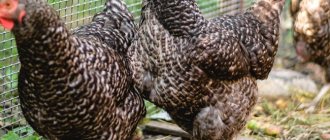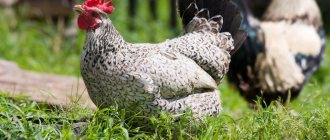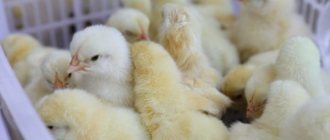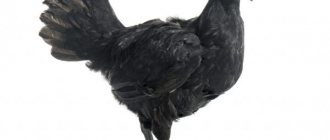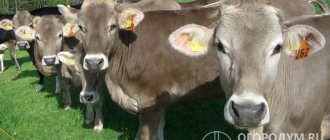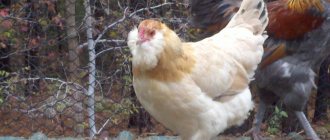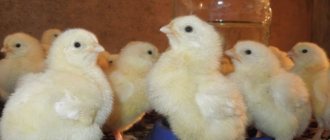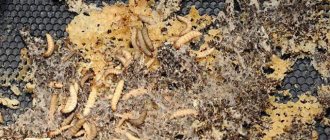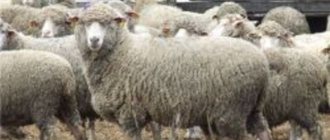In the chicken world, the Hubbard or Isa Hubbard broiler is famous for its large size and distinctive egg production. The versatility and unpretentiousness of growing conditions have made chickens of this variety in demand for keeping on an industrial scale and private farms. There are several varieties of Hubbard broilers, differing in their productive parameters. Details in the article.
Getting to know the view
Origin
The Isa Hubbard broiler was developed thanks to the efforts of bio-engineers from a large French company. The resulting variety of chickens turned out to be universal and advantageous in terms of meat and egg production.
Distinctive features
Breeders sought to combine unpretentiousness in care with high meat and egg productivity in one type of chicken. The average output from one three to four month old chicken is 2.5 kilograms of meat. And one mature hen produces about 200 eggs.
Removing the dwarfism gene from the genetic code of chickens allows them to reach up to 7 kilograms, and under more favorable conditions, up to 10 kilograms of weight.
Another distinctive feature of Hubbard broilers is their suitability for growing at home. Breeding such a bird does not require much effort - young animals have a high survival rate: from 97 to 99.
You can compare the productivity of other chicken species created in France in the article “French broilers”.
Appearance
Description of Hubbard chickens: medium-sized birds with a not very large head and a pinkish comb.
The color is predominantly white with hard plumage. The chicken is distinguished by a wide muscular chest and short massive legs.
The character is calm and flexible.
For comparison, check out another species in the article “Description of tetra broiler chickens.”
Varieties of Hubbard chickens are represented by five lines. Let's look at their main characteristics.
Description of the breed
Cross Isa Hubbard F 15 was obtained as a result of crossing using inbreeding. Breeders set themselves the task of obtaining fast-growing chickens that could easily adapt to being kept in any conditions. They also tried to achieve high resistance to various diseases. We managed to cope with all these tasks; in addition, laying hens are also distinguished by their high egg production.
The appearance of the birds is quite typical for broilers. Here is a brief description of the breed and its characteristics:
- The head is small and neat.
- The scallop is small, pea-shaped, bright red.
- The breast is muscular, wider in hens than in cockerels.
- The keel is elongated.
- The paws are powerful, the thighs are fleshy.
- The skin color is yellow.
- The color is white, the plumage is dense.
Like any broiler, the Hubbard F 15 cross has a calm character. Chickens and roosters never show aggression and can live closely together in rather cramped spaces. They behave phlegmatically and quickly make contact with the owner. They rarely get sick, which is why they are often grown in private farms. Even a novice poultry farmer can cope with breeding this breed. You can take a closer look at how broiler chickens look and behave in photos and videos.
Productivity
The Isa Hubbard chicken breed is highly productive. The main direction of their breeding is meat, but experienced farmers can get quite a large number of eggs from laying hens. The main indicators and characteristics of productivity are as follows:
- The weight of males at 35 days is 3.5 kg, hens - 2.7 kg.
- The weight of adult birds can reach 7 kg.
- The number of eggs per year is up to 200 pieces.
- The weight of one egg is 60-70 g.
- The eggshell is white and strong.
- Chickens begin to lay eggs at 5.5-6 months.
On most farms, crosses are sent for slaughter at 1.5-2 months. The best specimens are left behind to form the parent herd. At poultry farms, the Hubbard f 15 broiler is not used for egg production, since there are more productive breeds.
Broiler meat is very tasty and tender. When slaughtered early, it does not become fibrous and has a low fat content. Even in adult Chickens, the meat does not become too tough. If you want to use the egg production of chickens, it is best to keep them for up to two years. Then the number of eggs drops, and raising birds becomes unprofitable.
Five lines of Hubbard broilers
CLASSIC
Broilers of this line are unpretentious in breeding, are little dependent on temperature conditions and types of feed, grow quickly and gain weight.
FLEX
Chickens produce excellent offspring and quality of offspring survival.
The output can be a large volume of meat. Broilers of this subspecies have ideal proportions for slaughter - carcasses weighing from 1.8 to 3 kilograms.
H1
Hubbard H1 broilers have high output meat mass - from 2.5 to 4 kilograms. Carcasses are ideal for deboning.
F15
Chickens of this line are one of the most popular types of broilers in Russia. The second most popular is Hubbard Flex.
To breed the f15 species, small chickens were used. The result is obvious: maintaining such birds requires less feed, which does not affect the volume of meat obtained.
Due to its miniature size, the Hubbard f15 species is very popular for breeding at home. By 2 months, broilers gain on average 2.6-2.7 kilograms, roosters - about 3 kilograms. Chickens are excellent layers.
JV
It is distinguished by its reliability, productivity and economical breeding.
conclusions
Raising broilers (Isa Hubbard Flex or Irisa Hubbard Siberian) to produce low-calorie dietary meat is a very profitable business. But before starting breeding, it is necessary to select a highly productive breed. In most cases, broilers are not expected to produce eggs. But the exception in this case is Hubbard. Because per year from this cross you can get 200 eggs from one hen. In addition, he has the following positive indicators:
- Rapid gain of muscle mass with low feed costs.
- High survival rate. True, this is typical for almost all crosses.
- Adaptation to any conditions of detention. Both for floor and cell.
- Uniformity of the herd in terms of weight gain, absence of the dwarfism gene.
- Phlegmatic, calm character.
- The ability to quickly respond with weight gain to good care conditions and a balanced composition and nutritional standards.
But deviation from sanitary and hygienic conditions of keeping livestock can lead to illness and stunted growth of this cross.
All about maintenance and cultivation
Characteristics of the parent stock
The main task of the patrimonial herd is a year-round and uniform supply of young animals.
When forming a flock, you need to take into account that one Hubbard rooster on average can cope with 10 hens.
On a large farm, it is necessary to divide the livestock into separate “families” of 33 to 40 chickens. This is done to prevent infections and avoid conflicts between roosters.
Features of caring for males
Unlike the unpretentious care of chickens, keeping roosters requires compliance with certain measures.
Due to the fact that the Hubbard species is selectively bred, in pursuit of the amount of meat produced, the reproductive rate of roosters has decreased. Therefore, proper care of males is the key to stable reproduction of the herd.
Roosters require careful monitoring of their health and careful protection from stress, to which they are very susceptible. They must be marked. To do this, an incision is made in the membrane of the left paw, pressing the spurs and cutting the claws on the two supporting toes of both paws.
Requirements for the chicken coop and yard
The requirements for the condition of the chicken coop and farmstead for Hubbard broilers are almost the same as for ordinary chickens. Except that the room should be larger and the size of the farmstead smaller, since the main task of broilers is to gain weight.
The sunny side is the best place to arrange a yard. The ideal proportion is 5 birds per 1 square meter.
Let's consider the requirements for the condition of the chicken coop.
The floor of the chicken coop must be covered with non-toxic material and sprinkled with sawdust, straw or hay. In temperate climates, the volume of flooring averages 2-5 kg per 1 square meter.
The walls and floor are made of high-quality materials to prevent rodents from entering.
Lighting is provided from 16 to 18 hours. Wide windows with additional lights for the winter season are desirable.
Ventilation is carried out regularly. In stale air, Hubbard chickens can become sick and lose weight. Drafts are not allowed.
Diet and diet
Feeding Hubbard broilers requires complete nutrition, which can be easily provided by factory feed.
The basic diet should include barley, wheat, corn (ground), soybean meal, sunflower cake, meat and bone meal, pumpkin, fish meal, grass meal, yeast, chalk and milk powder. As well as fermented milk products, vitamins and minerals for intensive growth and weight gain of hens and chicks.
From 1 to 3 months, the composition of the feed remains virtually unchanged, only its quantity increases. Upon reaching 3 months, the chickens’ feed does not change.
Hubbard broilers allow you to save up to 8 kilograms of feed per chicken compared to conventional.
The description of the Hubbard broiler breed states that they independently control their appetite: broilers do not eat more than they need.
Hubbard chickens are especially sensitive to the state of drinking water, so it is necessary to clean the drinking bowls and change the water daily.
What to feed an adult flock?
In principle, almost everyone can eat hens. Let's consider several features of the diet for adult representatives of the French cross.
- An adult family also needs a diet with a predominance of grains.
- Cross-breed producers recommend feeding with porridge, or, as they also say, wet mash. Birds eat them with pleasure and easily digest them.
- The grain basis of the diet is compound feed for broilers, which includes the entire necessary range of nutrients.
- In small quantities, you can add protein products of animal origin to your diet - fermented milk, meat, fish.
Reproduction
Puberty of chickens and light regime
Chickens begin to lay eggs at 23-24 weeks. First you need to install nests for them on perches at a height of no higher than 50 centimeters from the floor.
Acceleration of puberty in Isa Hubbard chickens is achieved by adjusting the lighting. Starting from week 22, lighting should be provided according to a specific schedule:
- Week 22: daylight hours - 8 hours;
- From 23 to 24 – 10 hours of illumination;
- From 25 to 42 – the duration of daylight hours increases by 30 minutes;
- From 43 to 60 – 18 hours of illumination.
It is important to remember: chickens can only lay eggs when there is light.
When turning off the lights, it is important to maintain complete darkness. To avoid hens laying eggs on the floor, light must be supplied gradually, no earlier than 4 a.m. and in the evening.
Egg production
Hubbard chicken eggs differ little in taste from ordinary eggs. Broilers lay eggs with an average weight of 60-65 grams.
You can learn about the record holders for egg mass from the article “Which breeds of chickens lay the largest eggs.”
The physiological feature of molting Hubbard chickens is that after it the chickens begin to lay eggs better. Another positive aspect of changing feathers is the increase in growth and vitality of birds.
Therefore, forced molting has long been used by breeders to increase egg production. Caused by chemical, zootechnical and hormonal methods.
The change of plumage lasts approximately 2 months, during which the food ration is supplemented with multivitamins and minerals.
Pros of incubation
For Hubbard chickens, the incubation method of hatching chicks is preferable.
Incubation is better able to control and regulate livestock numbers.
The incubation period for conventional and selective chickens is the same. The difference is a 3-fold increase in the duration of ventilation of broiler eggs.
Chick hatchability fluctuates at a high level - from 98 to 99%.
Character
The Chanticleer breed of chickens has a leisurely but very curious disposition. These birds like a calm lifestyle, measured, without stress and shock. Nevertheless, clowns love people very much, become very attached to them, and then painfully endure separation.
All feathered Canadians are distinguished by their friendliness, tolerant attitude towards their relatives and the ability to find a common language without aggression and violence.
Winged beauties are not timid - when participating in exhibitions they are not afraid of crowds or unfamiliar surroundings, but behave with dignity and confidence, as if they understand that they are being admired. Due to their character, these quons do not create any problems for their owners.
Raising chickens
Premises requirements, temperature conditions and sanitary and hygienic measures
3 days before launching Hubbard chickens, the walls and floor of the room are treated with antibacterial agents (for example, formaldehyde), coated with lime and left to ventilate.
Strict adherence to temperature and humidity conditions is necessary, since Hubbard chickens are extremely sensitive to sudden changes in heat and moisture, due to which their growth and development may slow down.
From the first week of life, chickens must be maintained at 60 to 70% humidity and additional heating to 32 degrees.
From week 5, increased heating is excluded. Gradually, at intervals of 5 days, the temperature decreases by 2 degrees until it reaches 18 degrees. If the temperature is lower, the chickens will begin to consume more feed.
It is necessary to carry out sanitary and preventive procedures. For 4 days, the walls and floor of the chicken coop are treated with antibacterial agents such as Baytril or Enroflox. This is done from days 2 to 5, from days 25 to 28, and from day 35 of the chickens’ arrival.
Nutrition and vaccinations
Proper and balanced nutrition for Hubbard chickens is the key to their good growth and development.
Chicks are fed 8 to 10 times a day, including at night.
Feed for chickens is divided into 3 types: pre-start (from birth to 4 days), starting (from 5 to 13 days), finishing (from 14 to 30 days).
The diet for the first 4 days includes fermented milk products and grains.
Starting and finishing feeds consist of ground barley, sunflower cake, grass and fish meal, yeast with the addition of crushed shells, sand and chalk.
Factory compound feed, prescribed from the third week, is perfect for feeding chickens.
From day 5, chickens are prescribed vitamins and minerals to prevent the development of diseases. The drug "REX Vitala" is used.
Vaccinations are required: Gumboro (7 and 14 days) and Newcastle (21 days). A complete list of required vaccinations is discussed with your veterinarian. During mass vaccination, all vitamins and medicines are added to food or water.
Breeding specifics
To reproduce chickens of this breed, the formation of a parent flock is required. On the first day after purchasing the young, it is worth selecting the strongest and healthiest chicks. After this, it is important to monitor their weight gain. This is done at 2 weeks and 1 month.
For 5-6 females, 1 rooster will be enough. It is recommended to keep the herd in a separate pen. It should be fenced off from other birds. It is important that the diet of chickens and roosters is as balanced as possible.
Chickens of this breed are characterized by a weak maternal instinct. Therefore, it is recommended to keep eggs in an incubator or place them under females of other breeds. The survival rate of chicks is high and amounts to 96-98%.
Immediately after hatching, the birds are placed in a brooder. The temperature should be +32 degrees and humidity 70%. With an interval of 5 days, the temperature should be reduced by 2 degrees. It is worth considering that broilers are characterized by sensitivity to its changes.
In the first 5 days, birds need round-the-clock lighting. Subsequently, it is gradually reduced - by 1 hour per day.
There can be no more than 15 chickens per square meter. To ensure their normal development, it is worth keeping the room clean. It is recommended to remove litter 1-2 times a day. The poultry house needs to be systematically ventilated. It can be treated with ultraviolet light several times a day.
Disease Prevention
The main sanitary and preventive measures for keeping Isa Hubbard chickens are:
- Regular replacement and cleaning of flooring. When chickens are constantly indoors, cleaning is carried out daily.
- Pour food only into feeders. Containers for dry and wet food should be separate.
- Daily cleaning of drinking bowls, changing clean water, removing leftover uneaten food.
- It is mandatory to clean boots before entering the chicken coop, since often the owners themselves bring in various pathogens.
- Maintain cleanliness and dryness in the chicken coop, good ventilation, absence of drafts, sudden changes in temperature and humidity.
- Carrying out planned sanitary, hygienic and antimicrobial measures.
Feeding
In order for colored broilers to grow well, not get sick and produce a lot of meat/eggs, they must be fed properly - this is one of the most important conditions that cannot be ignored.
The best option for feeding birds that you are raising for meat is commercial prepared feed. Usually they initially contain all the necessary vitamins and microelements that the body of young individuals requires. They already calculate all the necessary proportions and number of calories.
Of course, you can prepare a balanced diet for colored broilers yourself. To do this you need to use the appropriate components:
- 90-100 g of oatmeal;
- 390-410 g cornmeal;
- 45-55 g derti barley;
- 190-205 g wheat derti;
- 1.5-2.5 g baker's yeast;
- 150-180 g cottage cheese;
- 55 g bone or fish meal;
- 140-145 g sunflower cake.
All of the listed components will need to be thoroughly kneaded. The resulting food should be given to the birds in accordance with their age, 10-20 g per bird.
To make the birds' skeletons stronger, they need to be given more calcium. To do this, the broiler should be fed eggshells, chalk or shells. These components contain a large percentage of calcium.
Birds, especially young ones, also need various vitamin supplements.
Before serving food to colored broilers, it is recommended to warm it up a little. You cannot feed individuals rice, buckwheat or other cereals in a raw state. Do not neglect these prohibitions if you do not want to cause serious harm to your poultry.
Cross "ROSS-708"
This new breed is far superior to the ROSS-308 and KOBB-500 broilers in various respects. It is distinguished by its early maturity, in which during the first month of a chicken’s life it is able to gain weight up to 2.9 kg. For poultry farmers, this speed of weight is the main advantage of the bird. The breed is distinguished by other positive qualities:
- white, weighty breast;
- large, powerful legs;
- quite a lot of meat;
- low cost;
- excellent survival rate;
- easy adaptability to different conditions.
In terms of its main characteristics, the cross resembles the KOBB-500 broiler chickens. They can easily be confused when kept in the same poultry yard.
When raising broilers on your farm or in your household, you should remember that first of all you need to choose the best breed. But it is not enough to know its characteristics and advantages. It is first recommended to study all the conditions of keeping and feeding broiler chickens, their diseases and methods of treatment.
How to choose the right one
To avoid problems, you need to understand the criteria for choosing healthy chickens:
Newly hatched chicks mostly sleep, but you need to pay attention to their appearance. The plumage must be completely dry, without bald spots; a healthy chicken sleeps sitting or standing; if it lies on its side, it means it is sick; the chick's head is slightly lowered, its eyes and beak are closed tightly; to make sure the chicken is healthy, you need to disturb it
The healthy individual will perk up, but the sick one will remain lying down; a healthy individual has a proportional body structure and stands firmly on its paws; the chicken should also be moderately well-fed; extreme thinness is a sign of ill health; chicks should have clean mucous membranes around the eyes, beaks and nostrils; There should be no traces of feces around the cloaca.
Did you know? The largest companies selling and raising beef breeds invest huge amounts of money in genomic research, which helps select the best cross breeders.

